
About Course
Laser fundamentals and applications. A Laser is a device that emits light within a process of optical amplification based on the stimulated emission of electromagnetic radiation. Because of its extremely high degree of monochromaticity, coherence, directionality, polarization, and power, etc.,
laser radiation or light has been widely used in high-resolution spectroscopy and imaging, chemistry, optical communications, biomedicine, defense industries, etc.
This course is intended for students who need to understand the basic principles of how lasers work and their main properties. This course provides the scholars a thoroughgoing knowledge of the fundamentals of lasers: their unique properties, their operations, and their applications.
It will equip the students with information on how a coherent light is generated and amplified, the techniques after different lasers design, and applications of laser in spectroscopy, chemistry, medicine, biology, military, and other areas.
Laser fundamentals and applications INTENDED AUDIENCE: Senior UG and PG students
Course Content
Laser : Fundamentals and Applications
-
Laser safety and summary
00:00 -
Non Linear Optics
00:00 -
Introduction to Non Linear Optics
00:00 -
Chemical and Dye LASERs
00:00 -
Gas LASERs
00:00 -
Semiconductor LASERs and Gas LASERs
00:00 -
Solid state LASERs
00:00 -
Passive Mode – locking and Types of LASERs
00:00 -
Mode – locking (contd.)
00:00 -
2nd order Nonlinear optics
00:00 -
Non-linear optical processes
00:00 -
Lasers in Material sciences and engineering and Optical Communications
00:00 -
Lasers in Medical Sciences
00:00 -
Laser Induced Chemistry and Ultrafast chemical Dynamics
00:00 -
Laser Induced Chemistry
00:00 -
Application of Laser: Enrichment of Isotope
00:00 -
Application of Laser: Laser Spectroscopy
00:00 -
Application of LASER: LIDAR
00:00 -
Aspects of SHG and Application of non-linear optics
00:00 -
Mode – locking
00:00 -
Mode Locking
00:00 -
Passive Q-switching, Mode-Locking
00:00 -
Components of LASERs
00:00 -
3-level System and 4-level system
00:00 -
Population inversion, 2-level system and 3-level system
00:00 -
Calculation of Einsteins coefficient
31:36 -
Einsteins Concept of stimulated emission
00:00 -
Interaction of Light with matter
00:00 -
Interaction of Light with matter
00:00 -
LASER and its history
00:00 -
Modes of LASER cavity and standing waves
00:00 -
Transverse Modes of LASER cavity
00:00 -
Q-switching and Pockels effect
00:00 -
Q-switching
00:00 -
Cavity Dumping
00:00 -
Some Numerical problem
00:00 -
Continuous and Pulsed Lasers
00:00 -
Properties of Laser: Coherence and Monochromaticity
00:00 -
Properties of Laser: Directionality and Intensity
00:00 -
Threshold Condition
00:00 -
Unique properties of LASERs and their applications
00:00
Student Ratings & Reviews

No Review Yet
